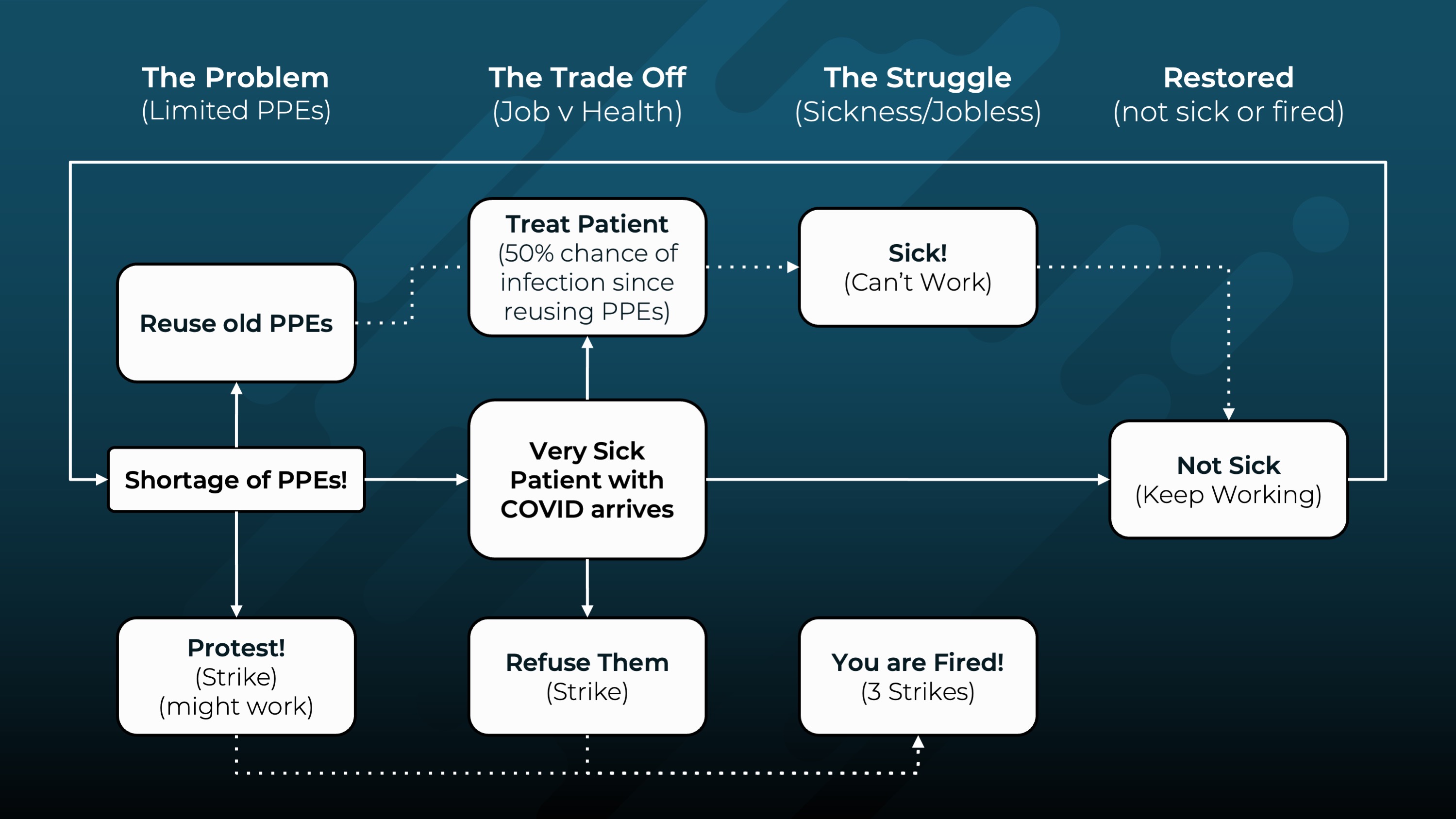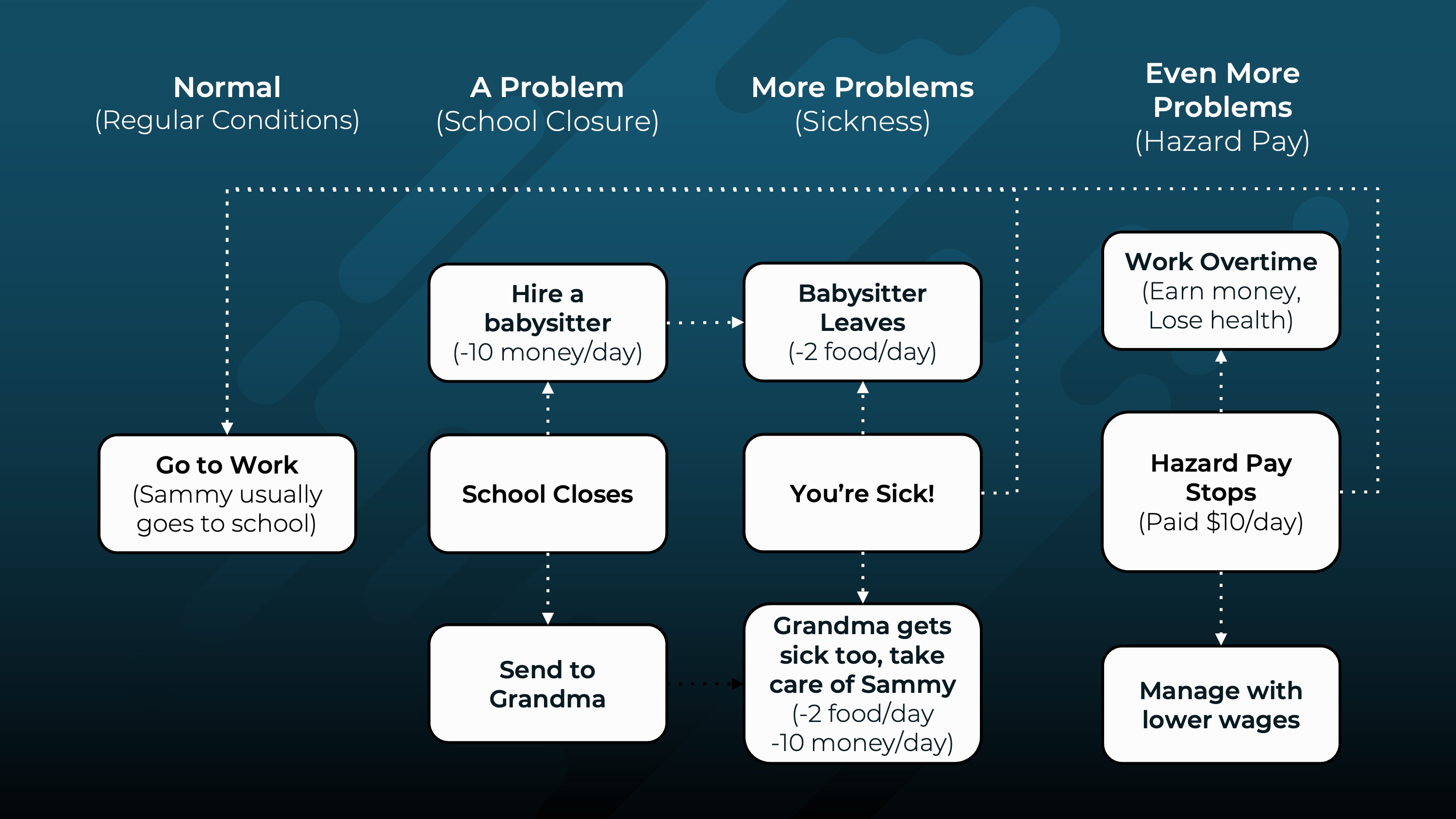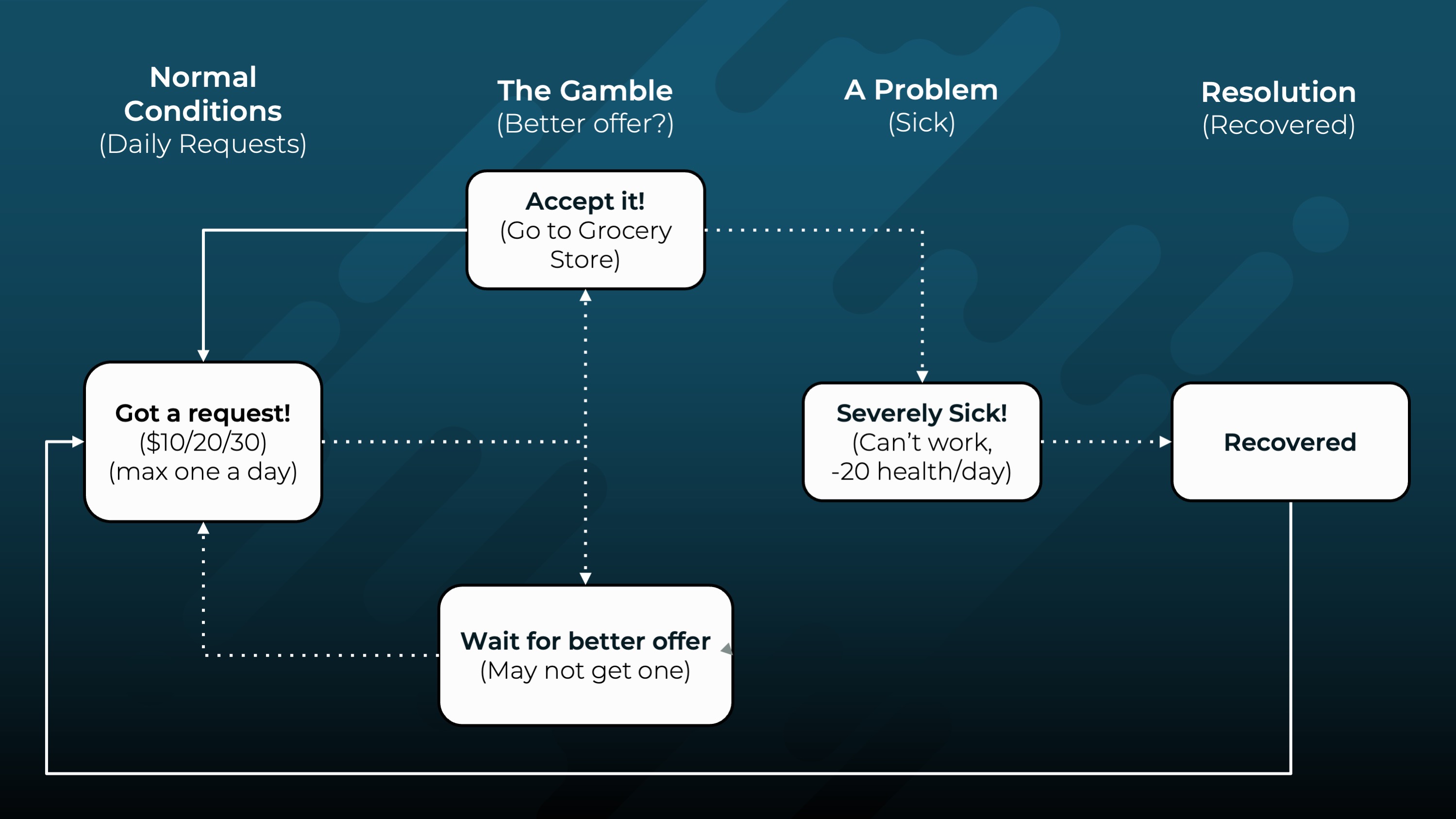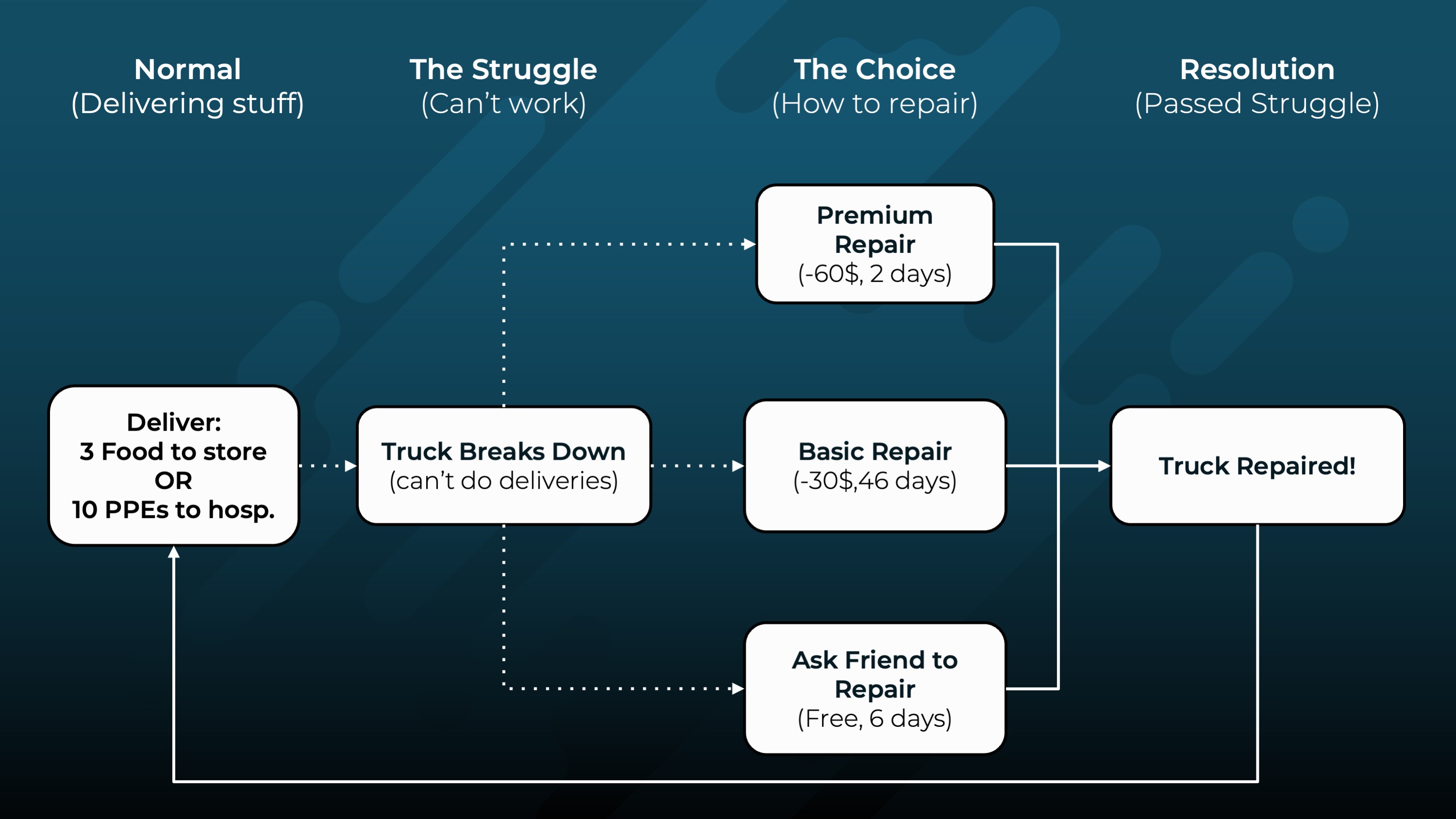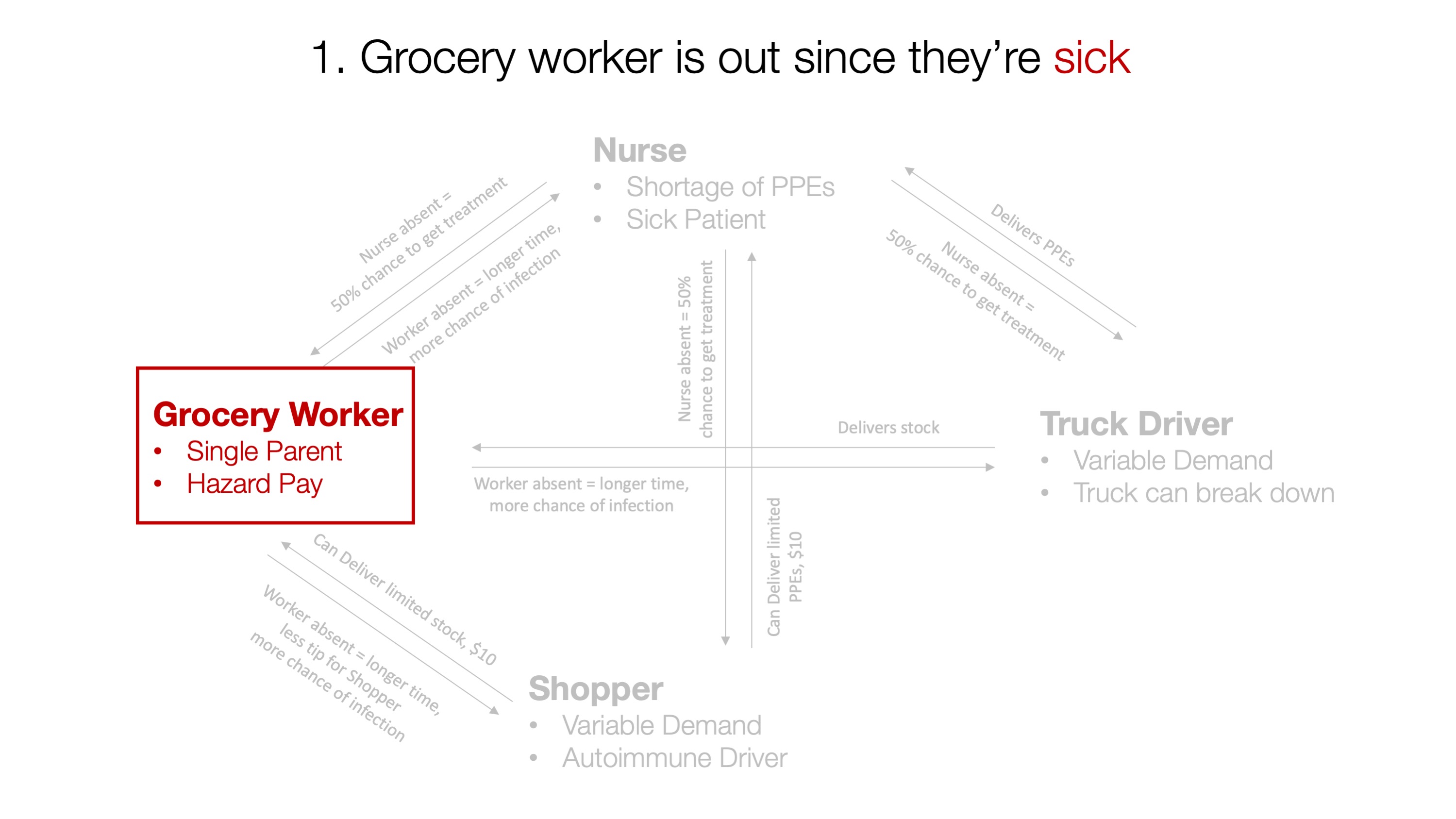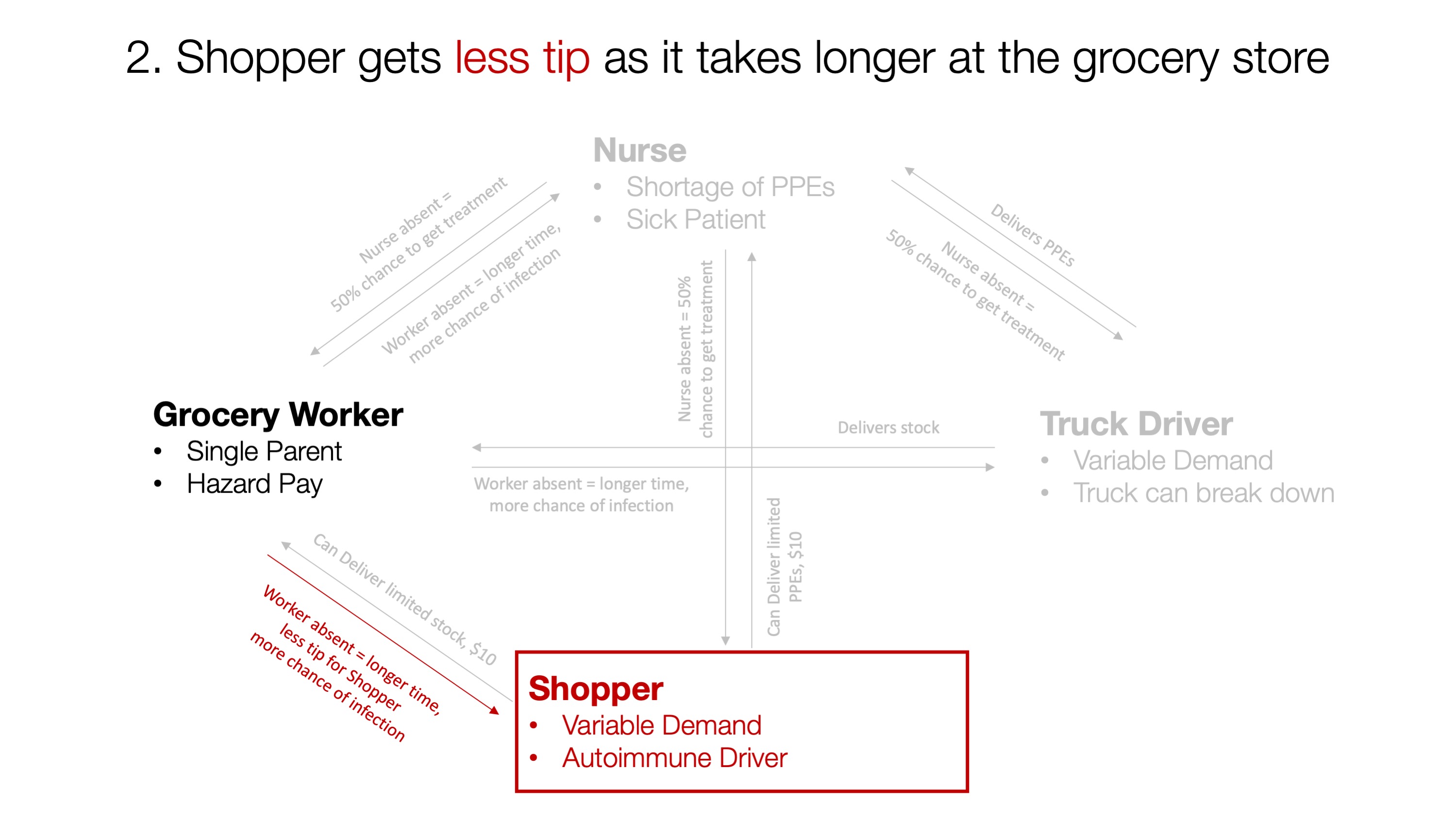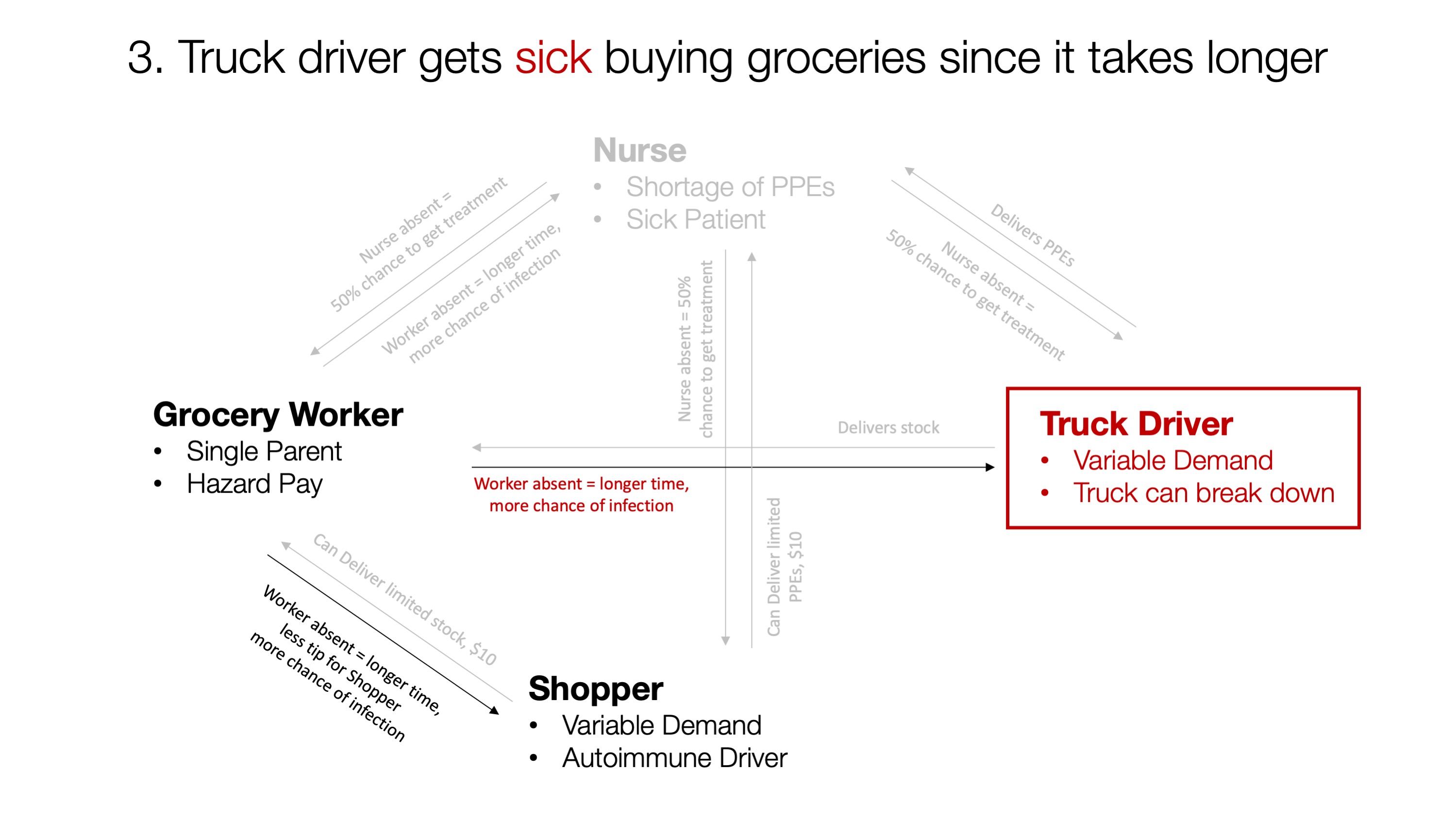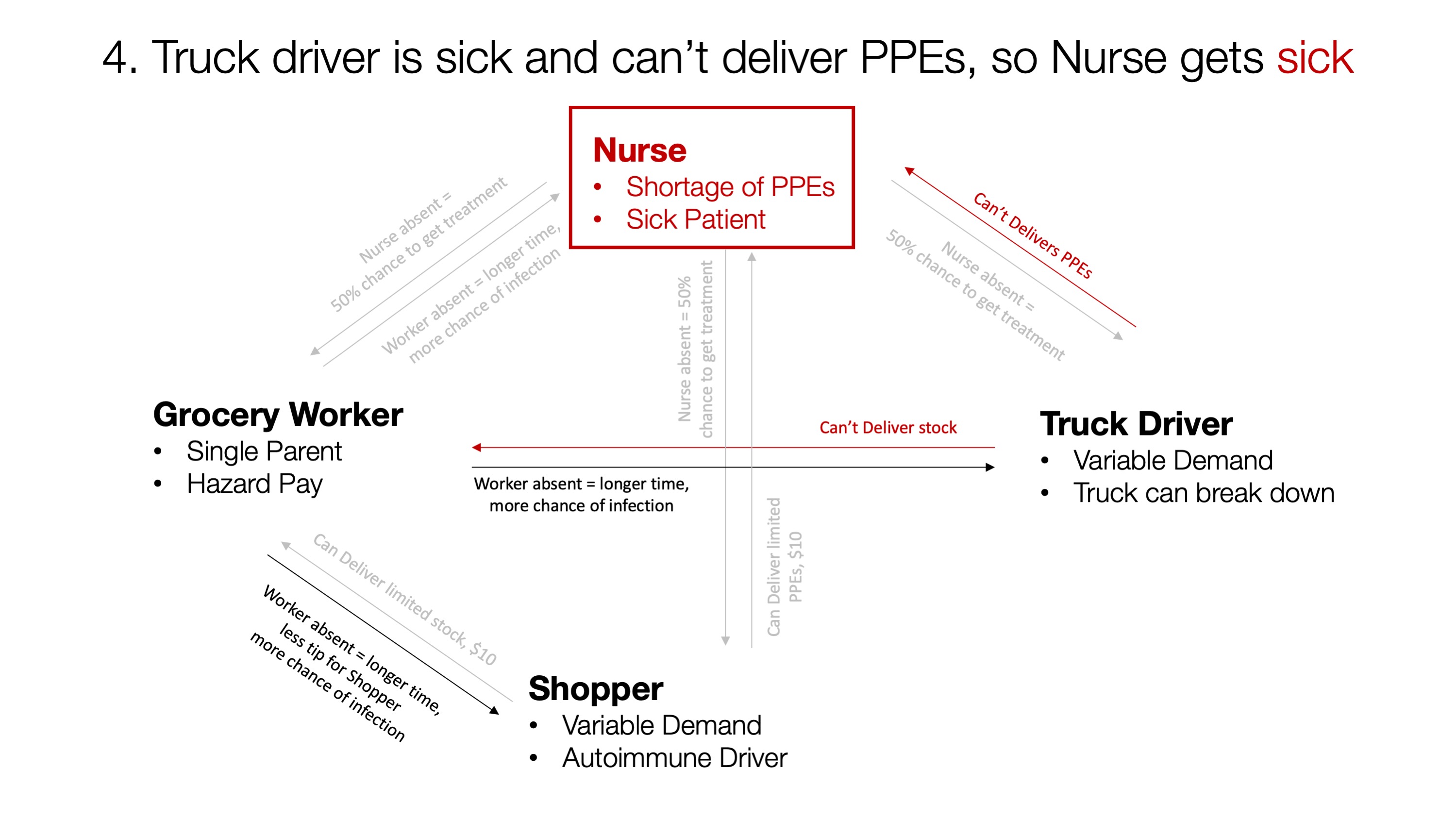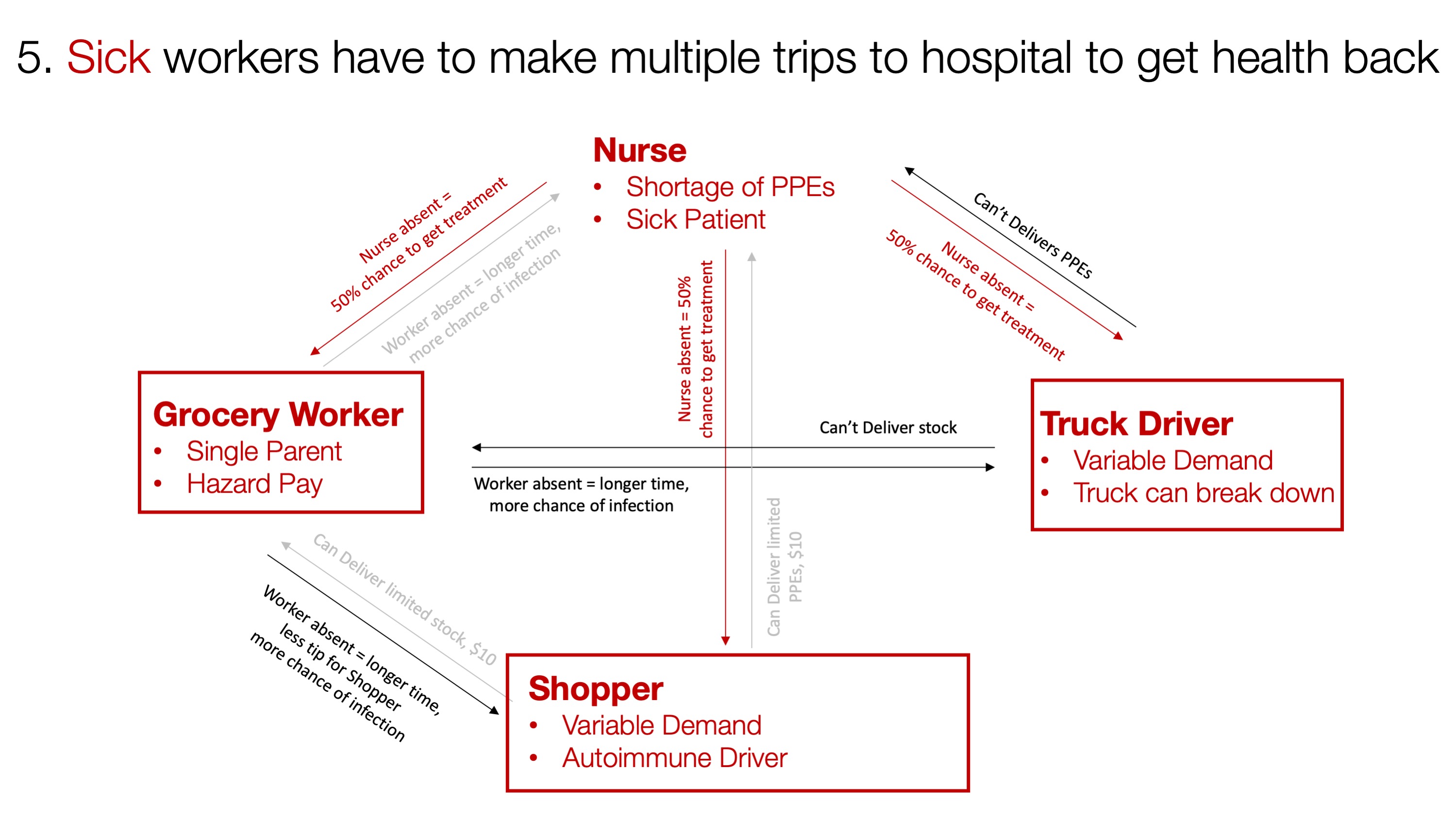Essential Workers
A cooperative game about a community working together to overcome the COVID-19 pandemic
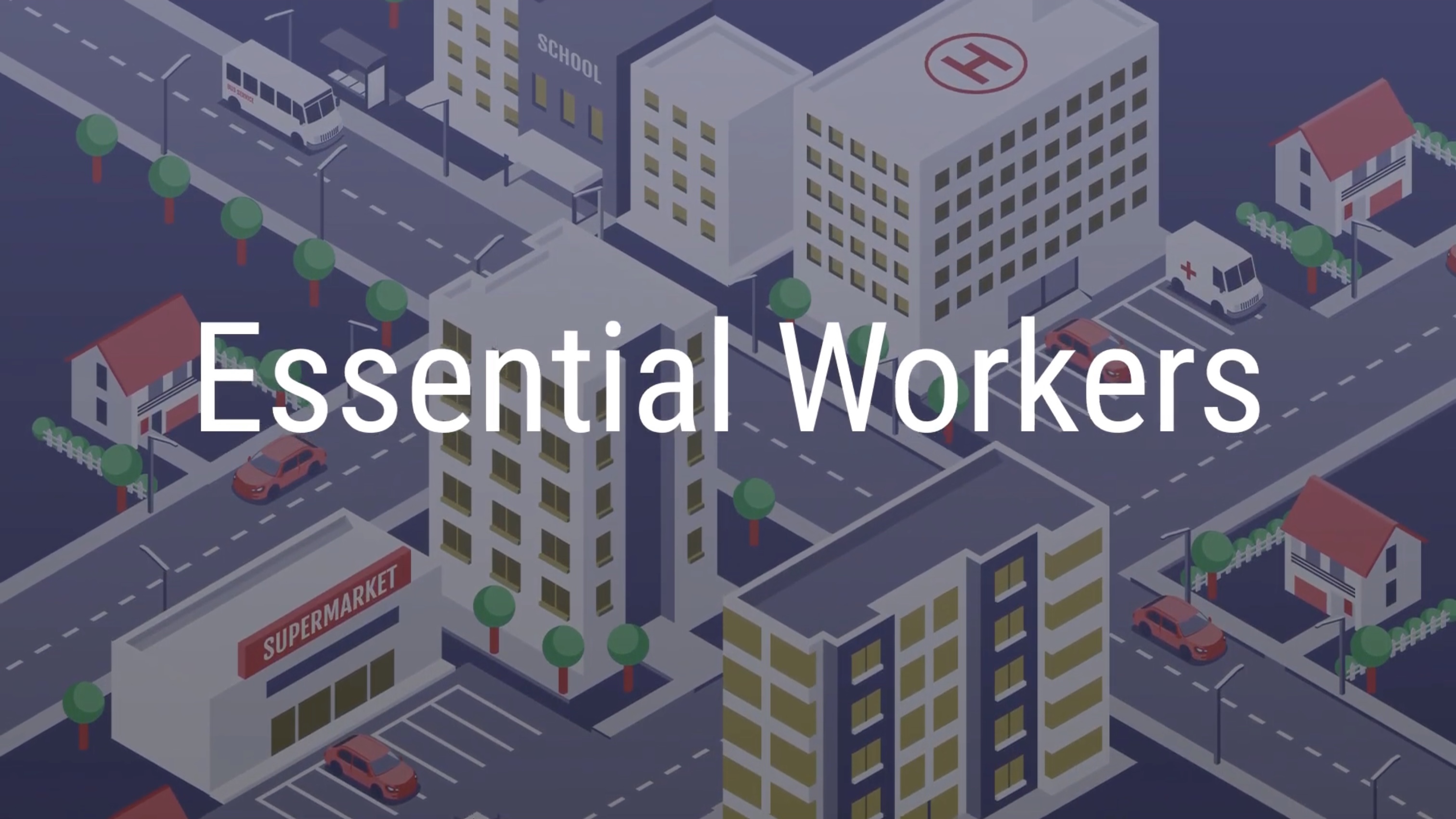
Trailer
Overview
Programming: P5.js/HTML/CSS
Genre(s): Multiplayer, Point & Click, Survival
Project Duration:
June 2020 – Aug 2021
My Role: Lead Designer: Mechanics, System, UI, Narratives
Developer: Event System, UI
Essential Workers is an online multiplayer game (upto 4 players) which situates players as one of 4 workers: Nurse, Grocery Store Worker, Grocery App Shopper, or Delivery Truck Driver. Players face difficult dilemmas as they live through 3 weeks of a pandemic. The game uses an epidemiological model built by researchers at Georgia Tech. This SIR model simulates how the Susceptible, Infected, and Recovered percentage of the population change over time in a community.
The game ties the stories of each character to each other and to the broader system. Every action players take affects others and can lead to ripple effects. For example, if the truck driver's truck breaks down, they can't deliver PPEs to the hospital, and the Nurse may be forced re-use old PPEs, increasing their chances of infection. In this way, Essential Workers aim to put players in the shoes of those who are fundamental to our society today and learn how the pandemic can strain all of us, even if it affects some of us.
Publications
- Aditya Anupam, Colin Stricklin, Jordan Graves, Kevin Tang, Michael Vogel, Marian Dominguez-Mirazo, and Janet Murray. 2020. Essential Workers A Multiplayer Game for Enacting Patterns of Social Interdependency in a Pandemic. In Extended Abstracts of the 2020 Annual Symposium on Computer-Human Interaction in Play (CHI PLAY '20). Association for Computing Machinery, New York, NY, USA, 173–177. https://doi.org/10.1145/3383668.3419863
The System
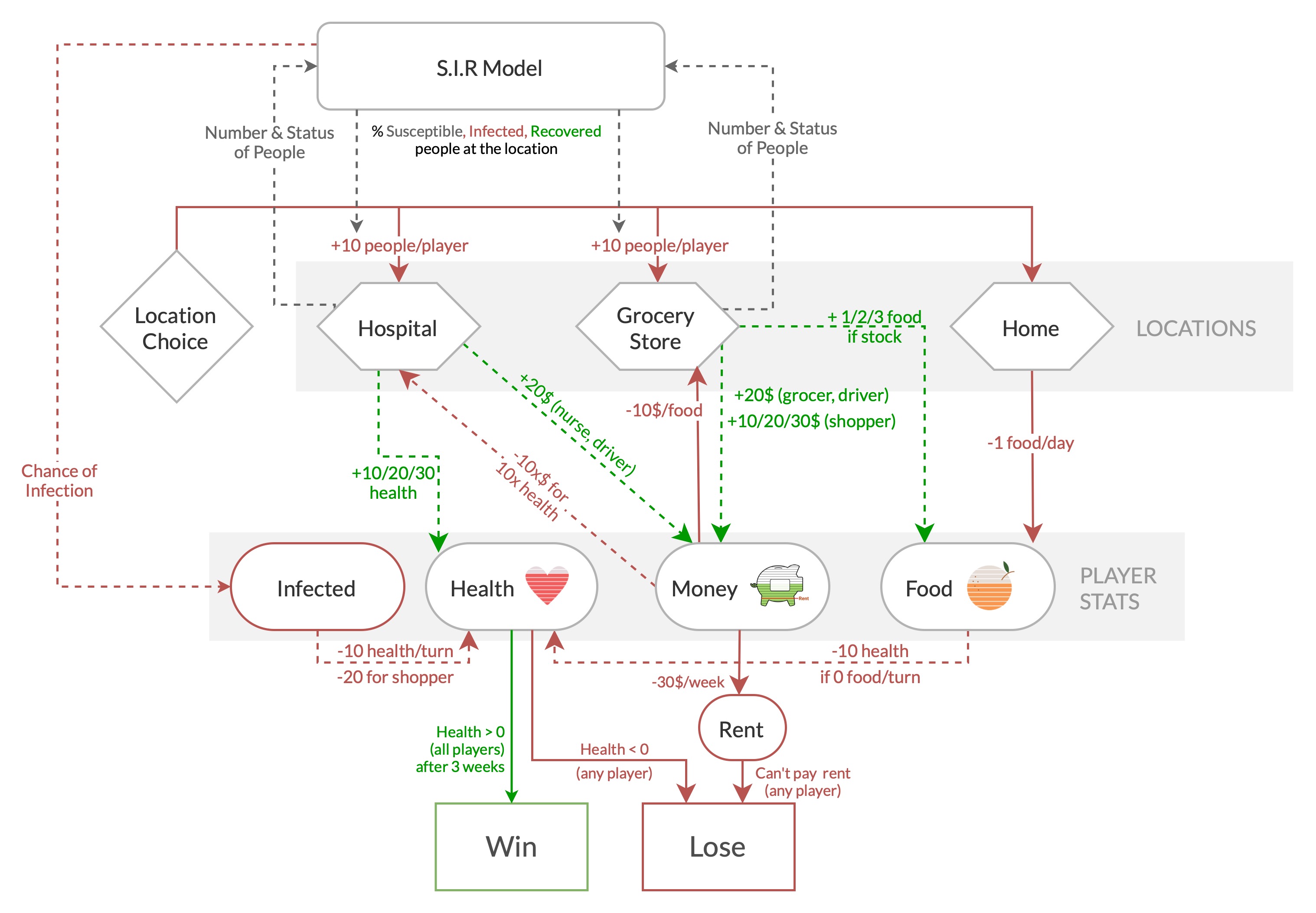
System Diagram illustrating the game economy. The key relationships pertain to the player's stats and how they change in response to their location choice + the epidemiological (S.I.R) model.
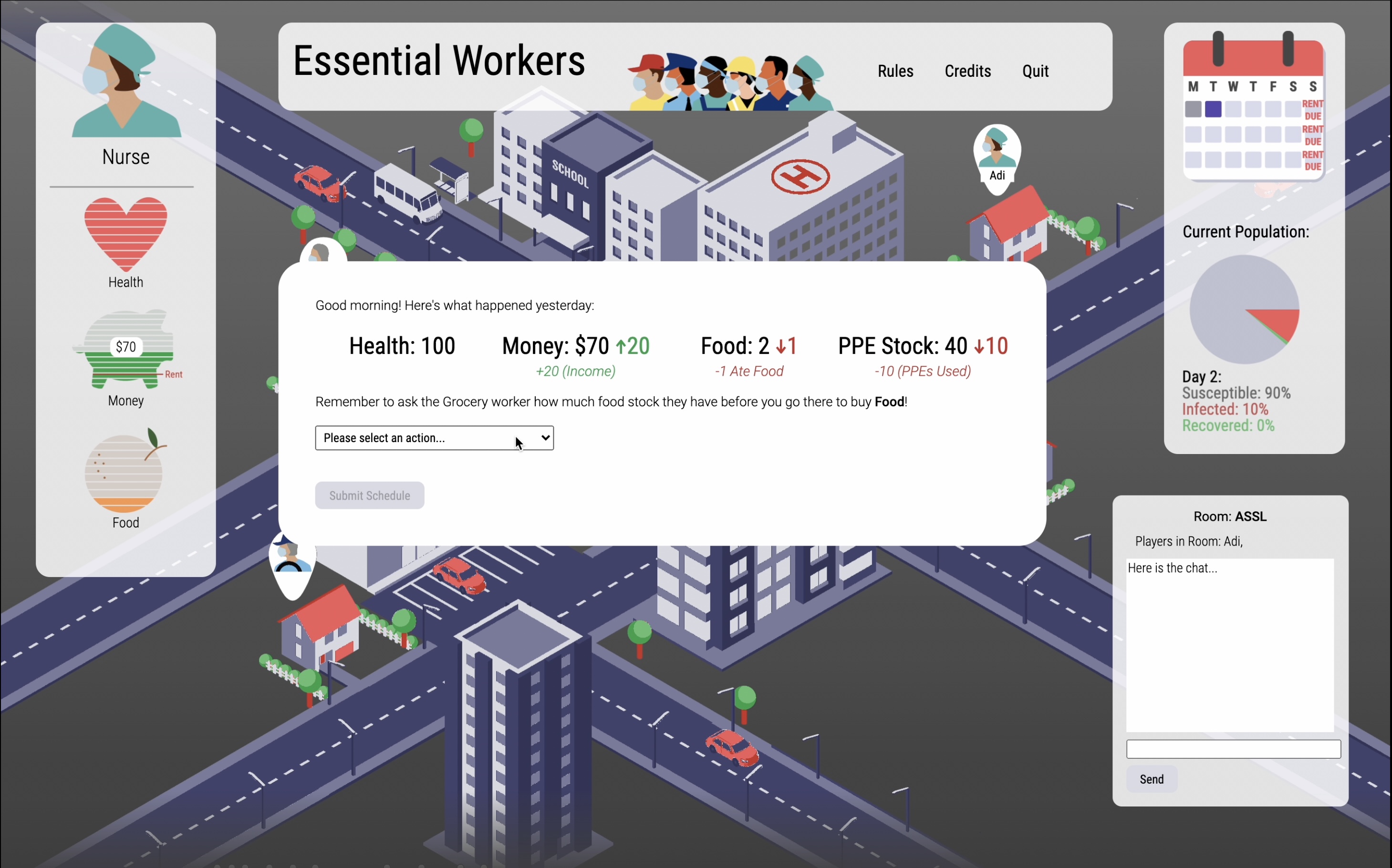
The game interface. Players stats (health/money/food) are on the left. The state of the general (background) population as calculated by the SIR model in on the right. The central dialogue box is where players make their location choice for their day and see what happened the previous day.
Game Mechanics
Mechanic 1: Daily Choice
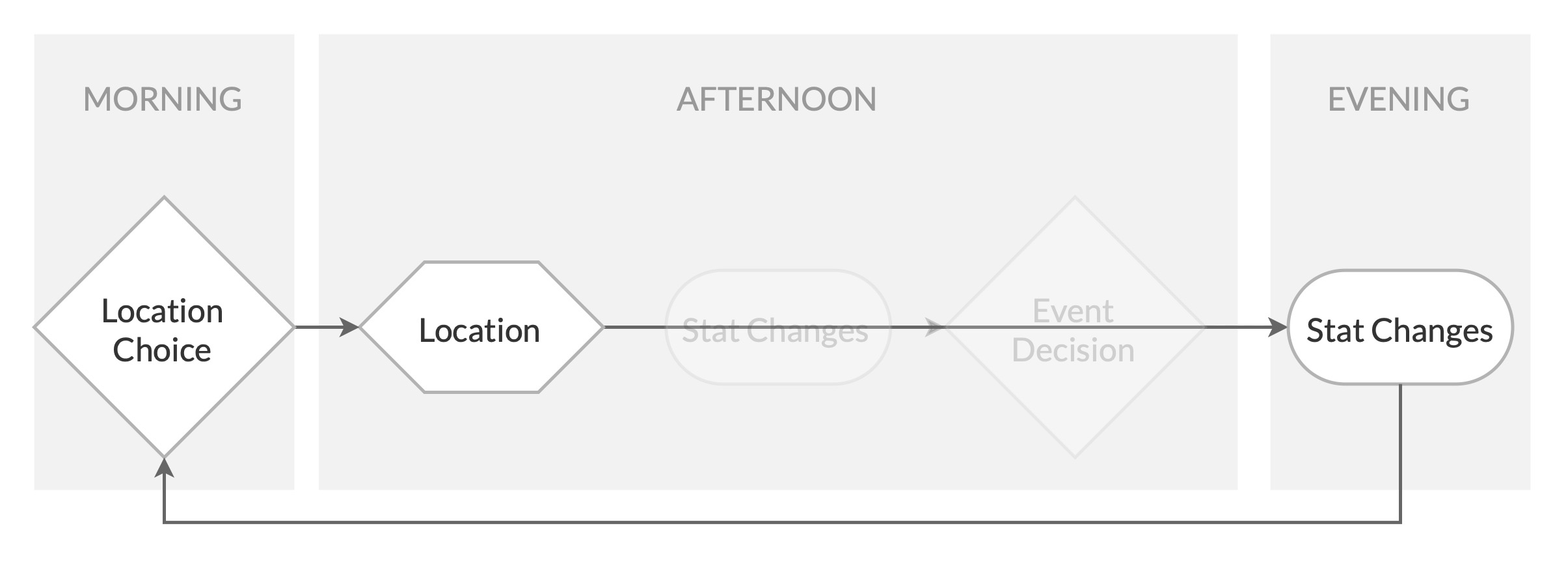
The core game loop. This cycle represents the normal day-to-day actions players make every day as events do not occur every day.
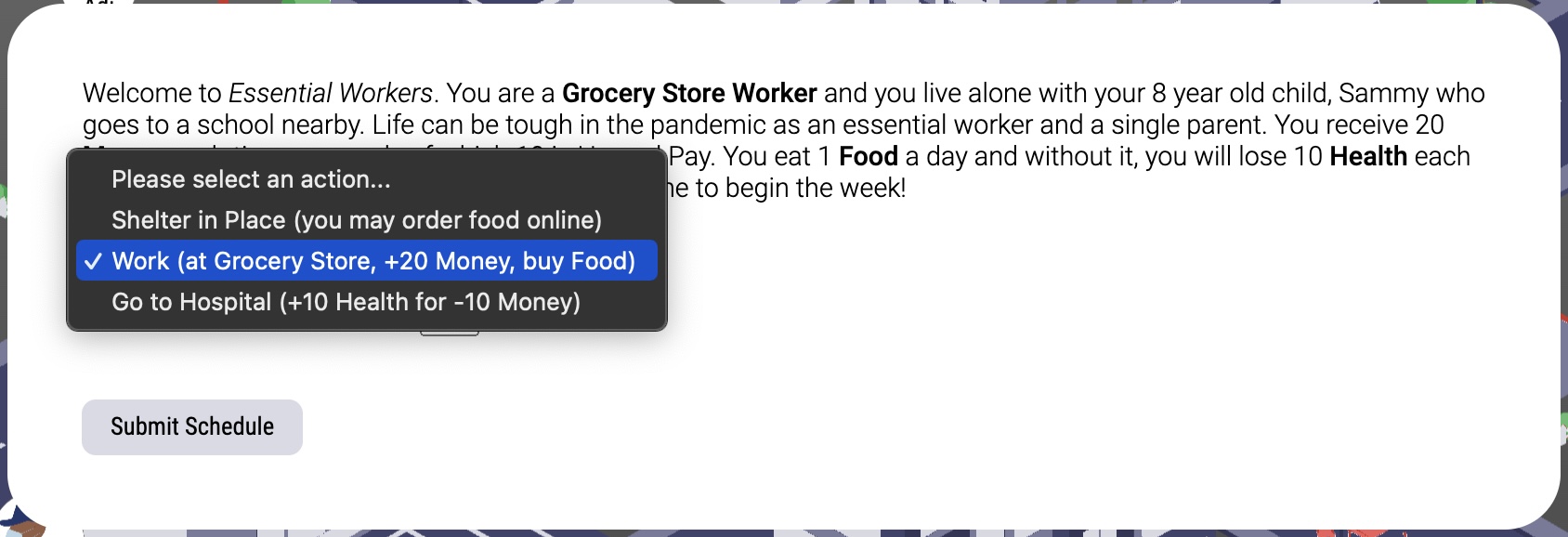
Morning: Players begin each day by selecting where they want to go. This decision will be affected by their character's job and what they need. The Nurse might want to go to the hospital to do their job, or to the grocery store to buy food.
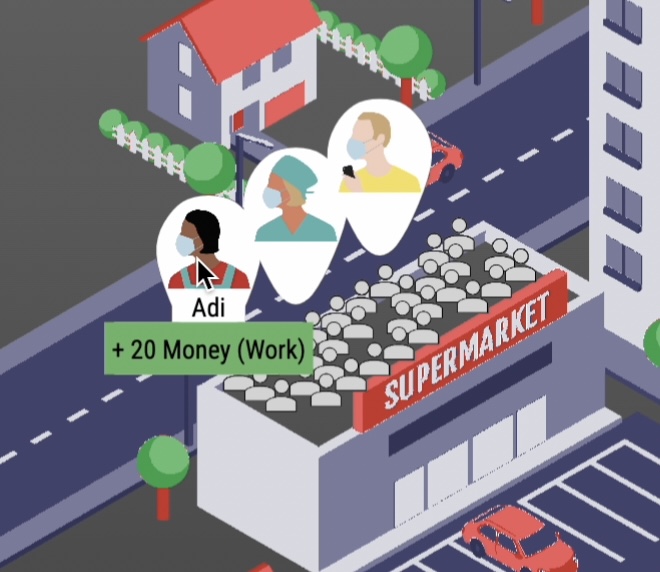
Afternoon: Upon reaching the location, certain stat changes will happen. For example, the grocery store worker will earn 20$ each time they go. Players can also get sick at this time. The rate of infection is calculated based on the number and status of people at the location. The more infected players there are at a location, the higher the chance of infection.
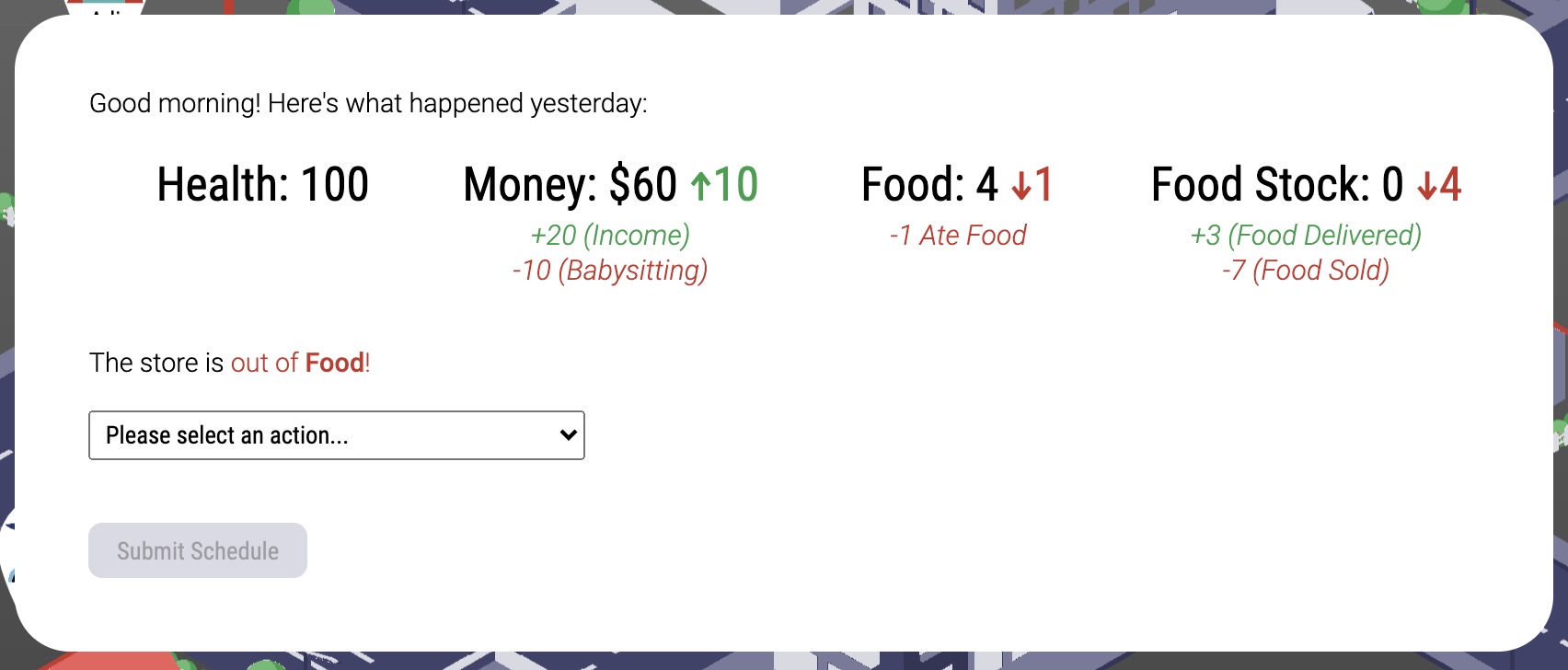
Evening: Players return to home in the evening and a summary is presented for all the stat changes/events that took place during the day. Then it turns back into morning and the cycle repeats.
(Video) The Daily Choice: The cycle of making decisions and seeing them through continues each day for 3 weeks.
Mechanic 2: Events (Three kinds)
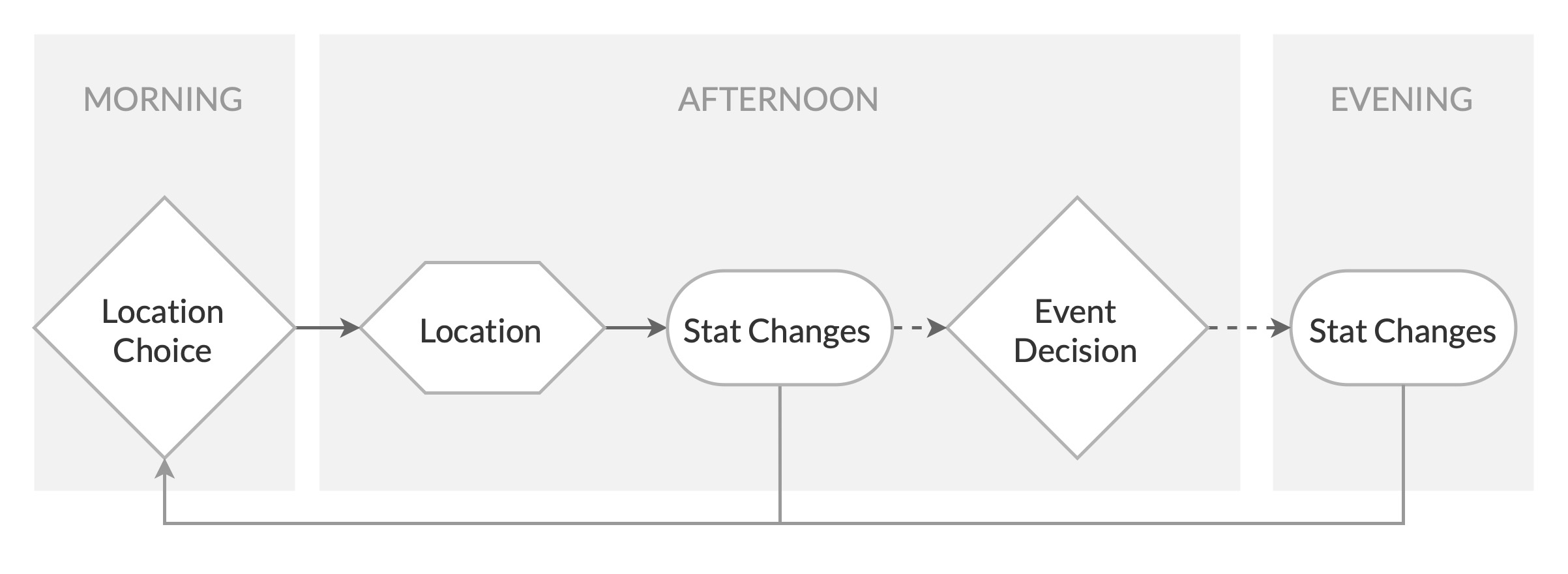
Full Game Loop: Players make a decision both in the morning (location choice), followed sometimes by another decision in the afternoon (the event decision).

Narrative Choice: Narrative choice events focus on story beats and are unique for each character. They usually have multiple options to choose from. For example, here the nurse has to decide what to do in the hospital given that they have run out of PPEs. Should they protest, or should they re-use the PPEs?

Narrative Info: Some narrative events may not require any decision-making. They simply inform the player of what they must do. For example, the grocery shopper here has waited long enough for a good offer and won't get any more for the day, so they must simply take the offer they have.
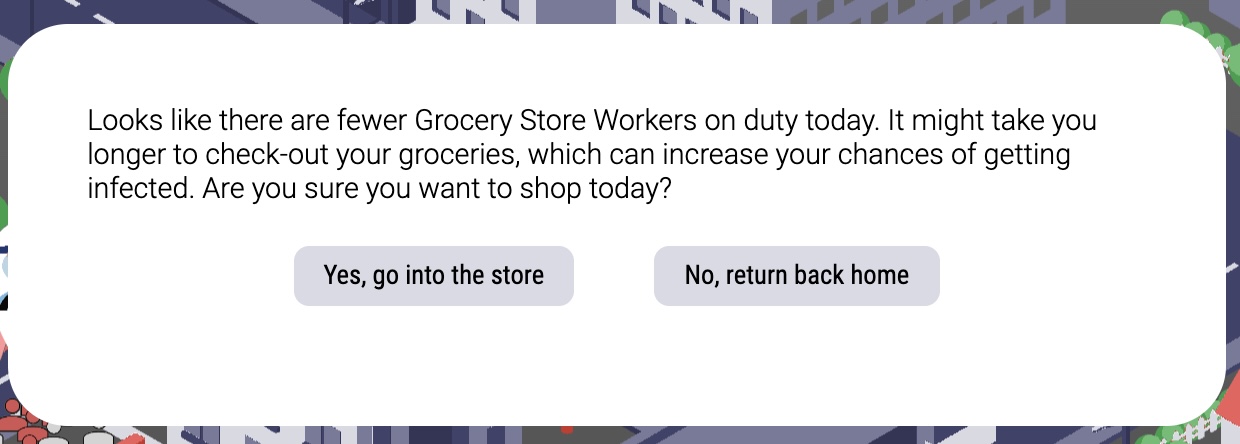
Warnings: These events warn the player about the potential consequences of going to a location and ask if they would like to re-consider. The player can then choose to not go into the location and instead return home.
(Video) Event Popups: Event decisions usually pop up after the morning choice in the middle of the day. They are simple dialogue boxed with choice options. The consequences of the event are usually discussed in the dialogue box for the next morning.
Narrative Design
Each character has their own unique premises which form the basis for their narrative design. Click on the tabs belown to explore each one!
Narrative Interdependencies (Carousel)
Each character's narrative and actions are also tied to the others and can lead to chain reactions. Explore the Carousel below to learn more!
Design Process: Prototyping
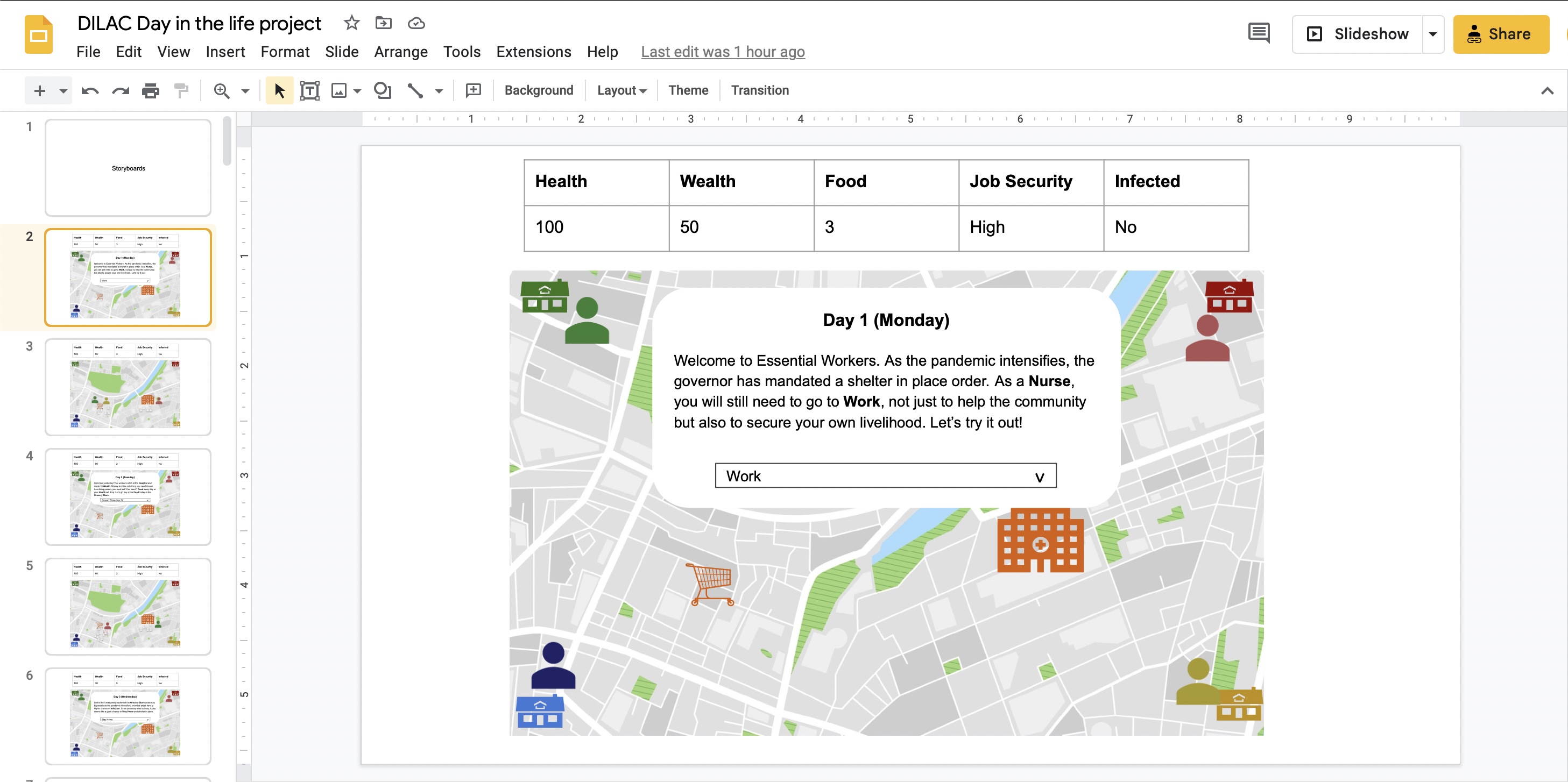
I developed the main prototype of this game using google slides. I drew up the basic map and characters and showed the progression of the game over multiple slides. The core mechanics I developed here such as choosing location, multiple players arriving together, and key stats (health, money, food) stayed consistent throughout the whole process.
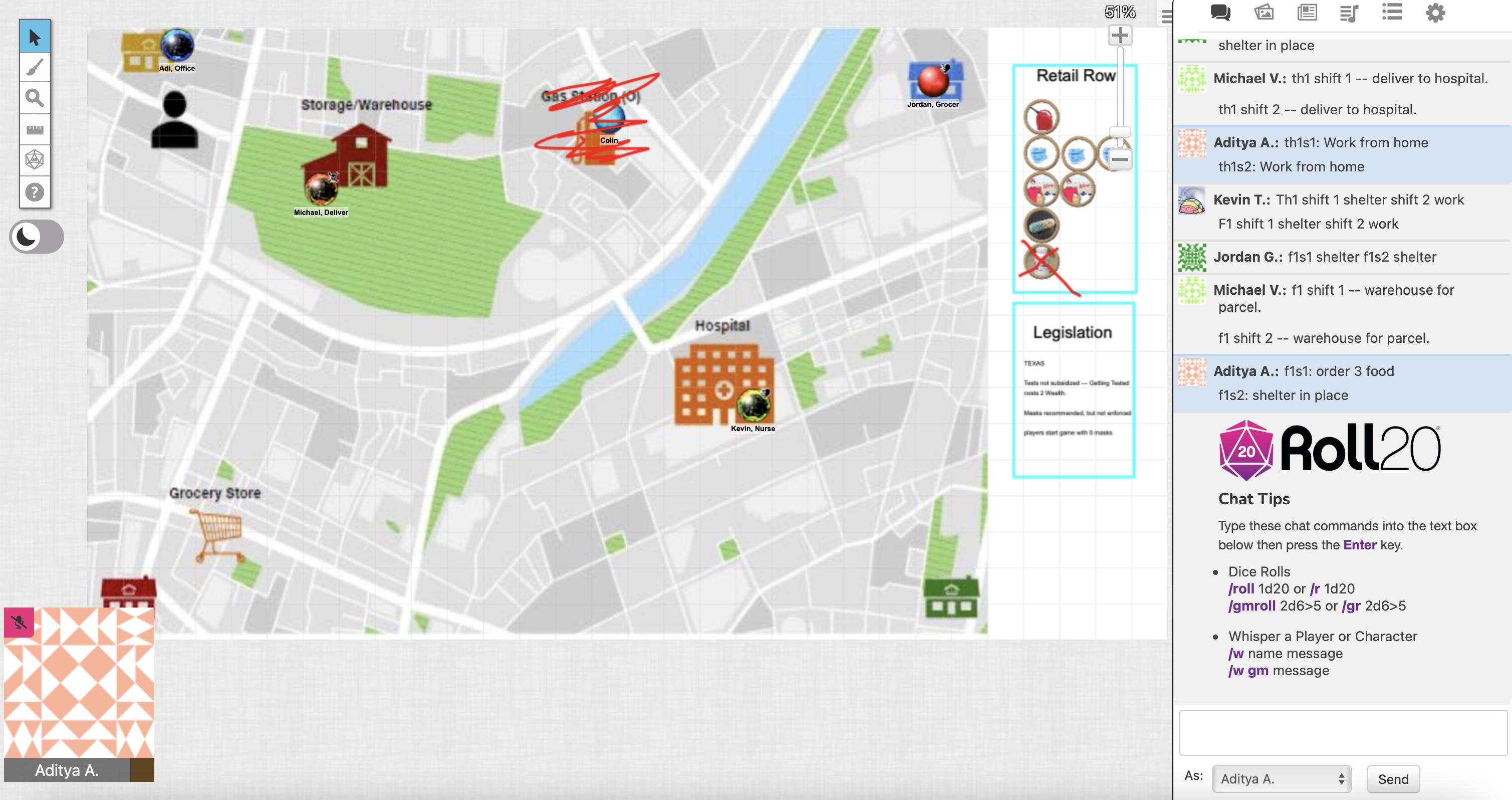
We tested this prototype using roll20. The platform is a tabletop allowed us to simulate the game as a tabletop experience. We could roll dice here as a simulation of probability of spreading infection and recovering.
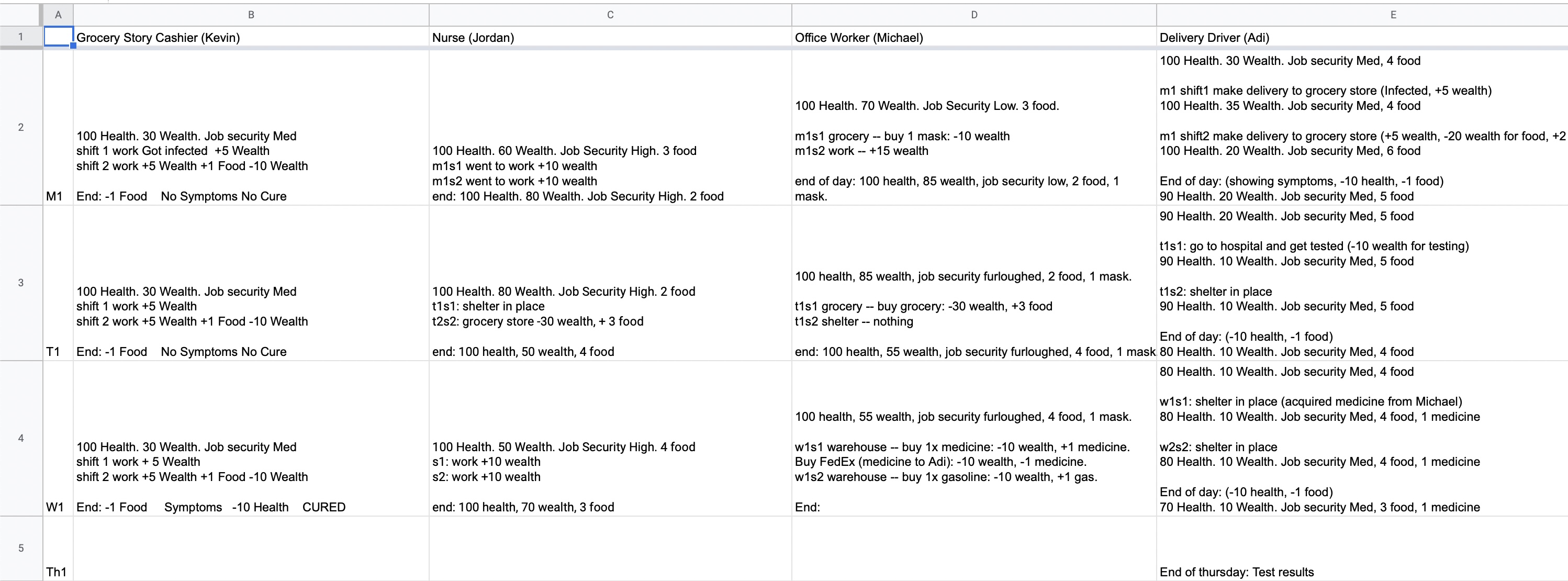
Simultaneously we wrote down our stats for each day and how they changed using google sheets.
Design Process:Iterations
Gameplay
The first iteration had no stories and purely attempted to capture the epidemiological phenomenon of disease spreading. It also did not have a tutorial and only supported multiplayer play. It had only blank character designs. This was our submission to the INDCOR Complexity Jam in 2020. The game was made in 1 week.
The second version added a more personal touch to the gameplay through narrative events, allowing players to better understand the impact of the pandemic on the daily lives of the workers (and vice-versa). It also improved the UI, added characters with some emotion, a tutorial mode. It also added an end-screen that showed if players survived or failed.
The current version incorporated intertwined narratives which allowed players to clearly examine how the personal lives of esssential workers are interconnected as they depend one each other. It further improved the UI and added single-player support.
Map
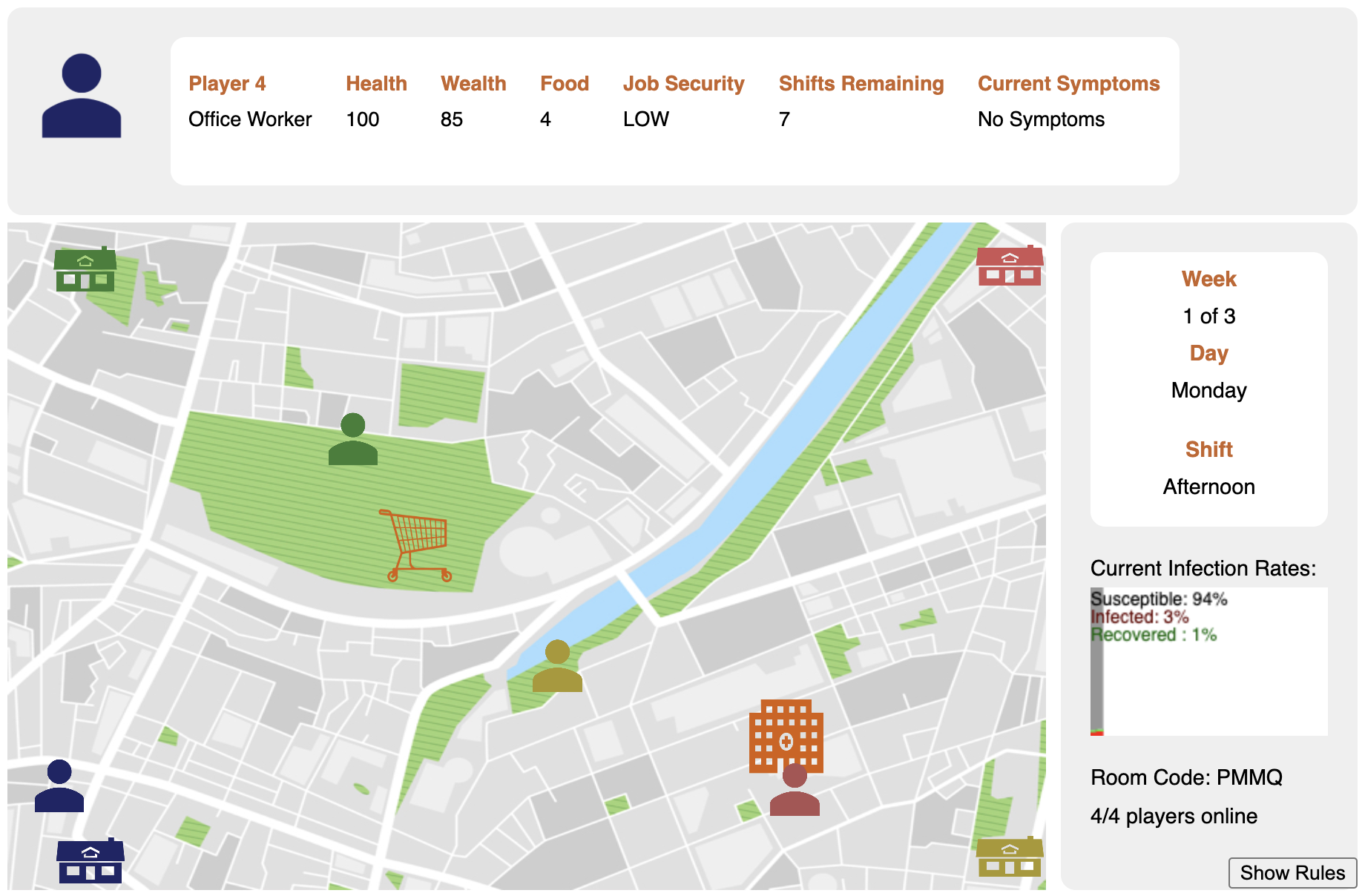
Copied Map
The first map of the game was taken from a google image search and was meant to function purely as a placeholder. The interface was also implemented in a purely functional way.
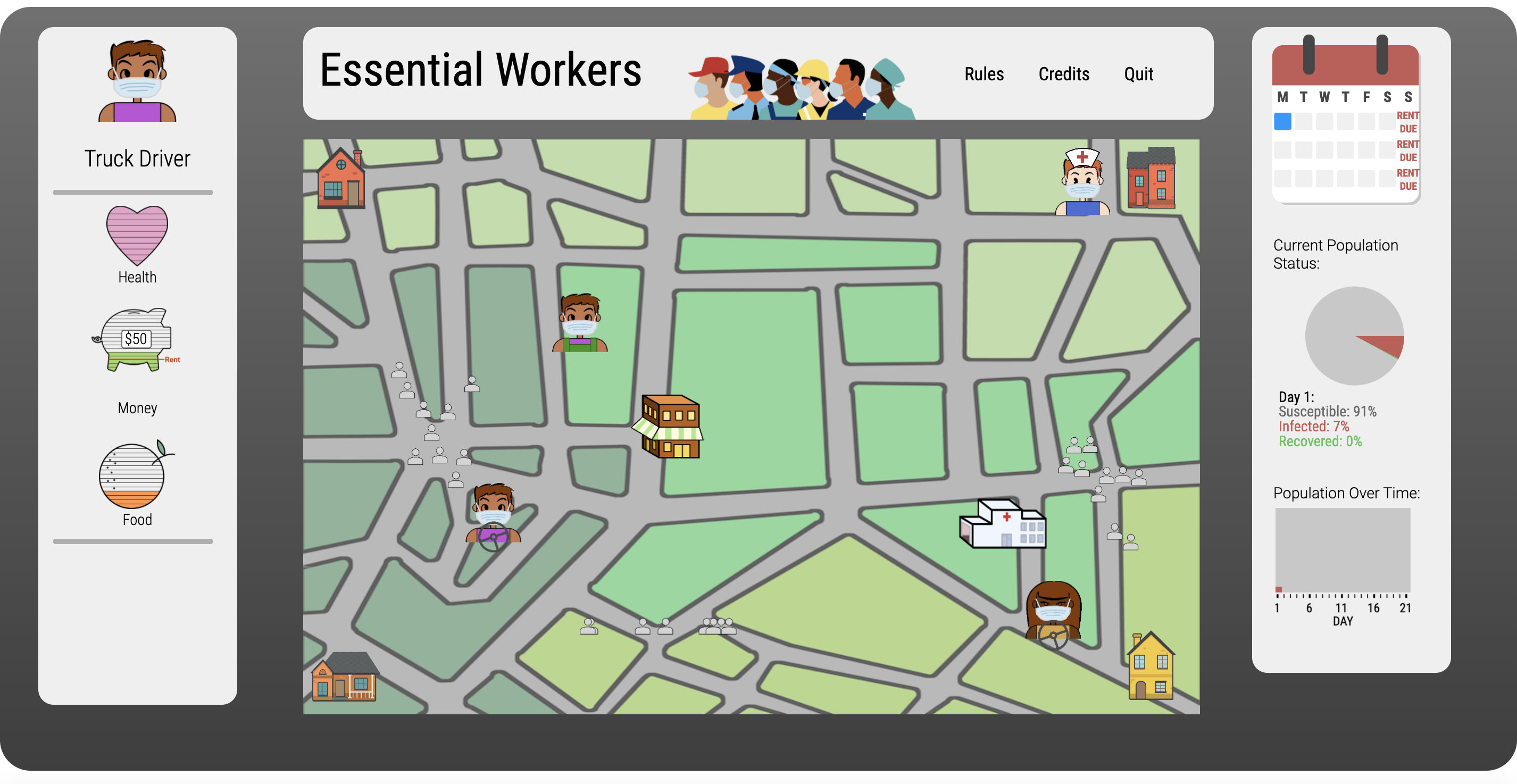
Self-made Map
The second map was created by one of our team members. The UI was also improved to be more spacious and to change color in the background when players became sick. This map and the characters however felt too cartoony and not appropriate for the subject-matter
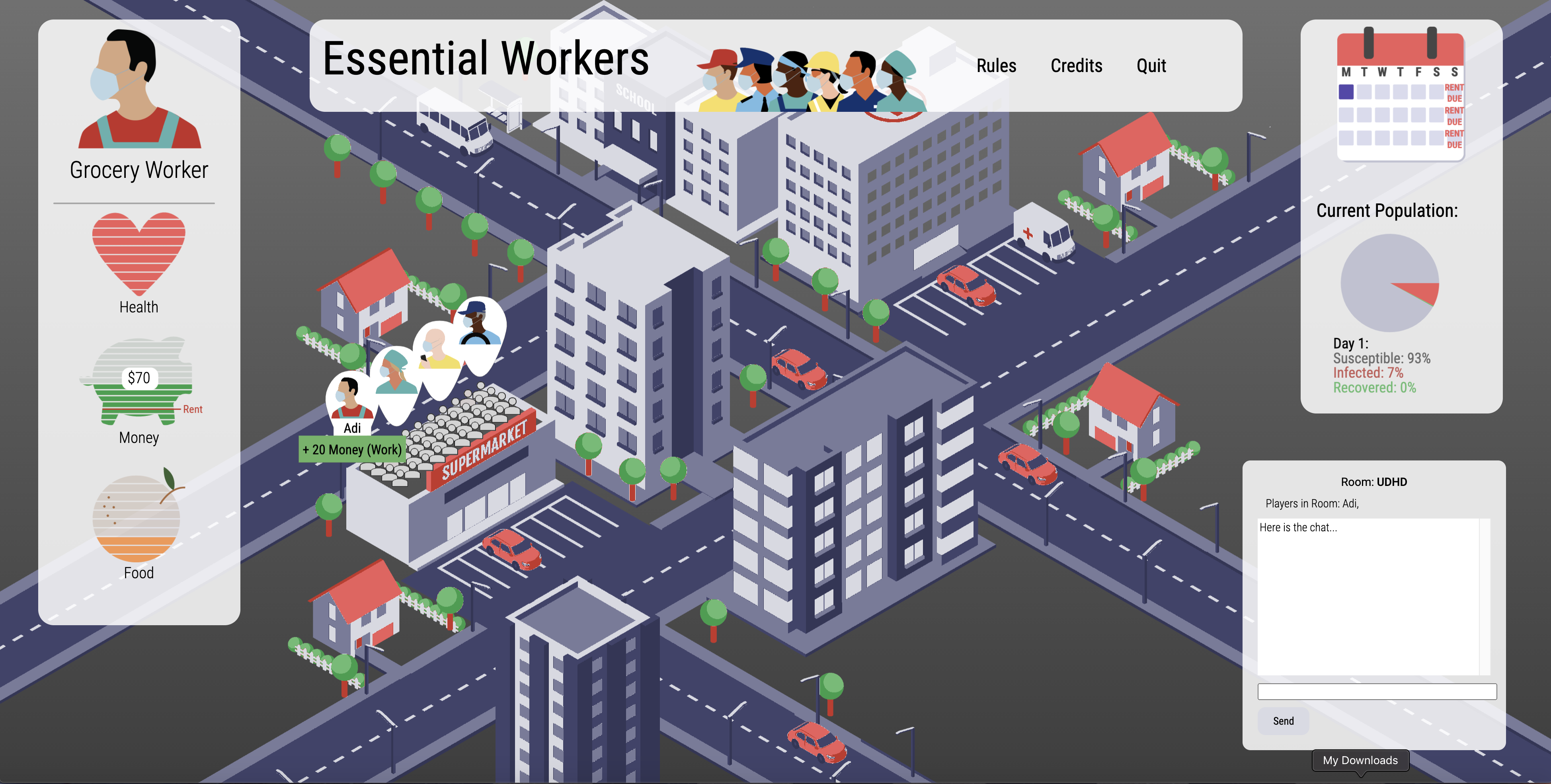
Isometric Map
The current version implements an isometric map and more serious character designs. The UI is also better integrated into the map.


